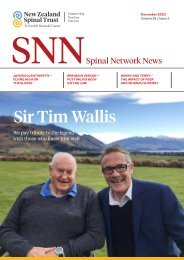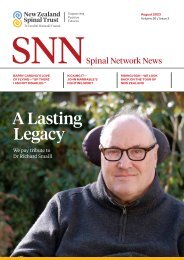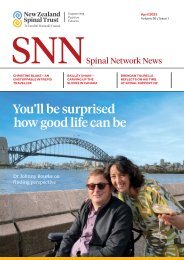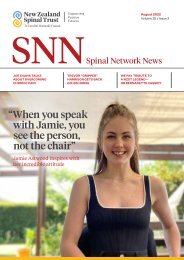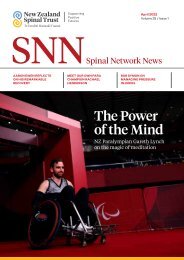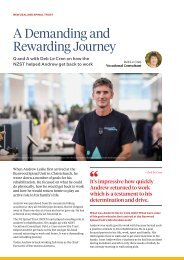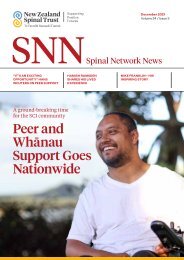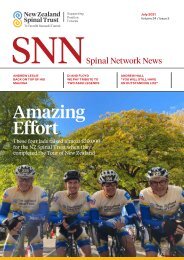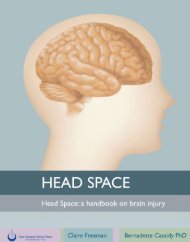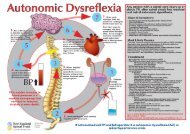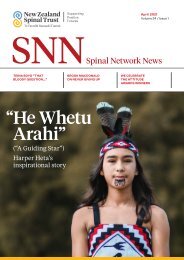SCI Action Plan 2014-2019
You also want an ePaper? Increase the reach of your titles
YUMPU automatically turns print PDFs into web optimized ePapers that Google loves.
New Zealand<br />
Spinal Cord<br />
Impairment<br />
<strong>Action</strong> <strong>Plan</strong><br />
The best possible health and wellbeing<br />
outcomes for people with spinal cord<br />
impairment are achieved,<br />
which enhances their quality<br />
of life and ability to<br />
participate in society<br />
Photo provided courtesy of the NZ Spinal Trust
Citation: New Zealand Spinal Cord Impairment <strong>Action</strong> <strong>Plan</strong> <strong>2014</strong>-<strong>2019</strong><br />
Wellington, ACC and the Ministry of Health<br />
Published in June <strong>2014</strong> by ACC and the Ministry of Health<br />
Wellington 6145, New Zealand<br />
ISBN 978-0-478-42812-4 (print)<br />
ISBN 978-0-478-42813-1 (online)<br />
This document is available at www.health.govt.nz and www.acc.co.nz
Contents<br />
Why New Zealand needs an <strong>Action</strong> <strong>Plan</strong> 3<br />
Introduction 3<br />
Definitions and scope 4<br />
Development approach 4<br />
What we aim to do 5<br />
Vision 5<br />
Purpose 5<br />
Principles 5<br />
Implementation and governance 7<br />
Objective 1: Improve acute clinical outcomes for adults requiring acute <strong>SCI</strong> care 8<br />
Objective 2: Improve outcomes for children and adolescents 11<br />
Objective 3: Improve information sharing 14<br />
Objective 4: Provide nationally consistent <strong>SCI</strong> rehabilitation services and extend<br />
community-based rehabilitation 17<br />
Objective 5: Review and align the Ministry and ACC processes for access to equipment,<br />
housing modifications and transport 22<br />
Objective 6: Develop peer support services 25<br />
Objective 7: Build health and disability workforce capability 27<br />
Objective 8: Support improvements for carers taking a cross-agency approach 30<br />
Appendix 1: Draft national acute destination guidelines and draft national acute referral guidelines 33<br />
Appendix 2: Draft acute <strong>SCI</strong> pathway with DHBs and ambulance services 35<br />
Appendix 3: Draft <strong>SCI</strong> pathway developed for children and adolescents 36<br />
New Zealand Spinal Cord Impairment <strong>Action</strong> <strong>Plan</strong> <strong>2014</strong>–<strong>2019</strong><br />
I<br />
1
Acknowledgement<br />
ACC and the Ministry<br />
of Health would like to<br />
thank the many people<br />
who have contributed to<br />
the development of this<br />
<strong>Action</strong> <strong>Plan</strong> and willingly<br />
shared their time,<br />
personal experience<br />
and vast wealth of<br />
knowledge. The input<br />
of many individuals<br />
and organisations<br />
with personal and<br />
professional experience<br />
of spinal cord<br />
impairment has been<br />
vital in shaping this<br />
<strong>Action</strong> <strong>Plan</strong>.<br />
Photo provided courtesy of the NZ Spinal Trust<br />
2 I
Why New Zealand needs an<br />
<strong>Action</strong> <strong>Plan</strong><br />
Introduction<br />
Complexity<br />
Spinal cord impairment (<strong>SCI</strong>) is rare but complex.<br />
Every year in New Zealand approximately 80 to<br />
130 people are diagnosed with <strong>SCI</strong> through injury<br />
or medical/congenital causes. This affects their<br />
lives and those of many others, especially their<br />
families and whānau. <strong>SCI</strong> can occur at any age<br />
from birth, during childhood or as an adult. Due to<br />
medical advancements most people living with <strong>SCI</strong><br />
now have a near normal life expectancy, but this<br />
brings with it progressive complexity for people<br />
and their lifelong self-management.<br />
Coordination<br />
The management of <strong>SCI</strong> is both complex<br />
and challenging. It requires a specialised<br />
multidisciplinary and coordinated approach<br />
across the continuum from initial presentation,<br />
assessment and diagnosis, through to life in the<br />
community.<br />
In New Zealand, the current model of care for<br />
medical interventions and lifelong supports is<br />
fragmented and needs better coordination.<br />
Variable and inconsistent approaches to accessing<br />
services do not deliver the best health, wellbeing<br />
or life expectancy outcomes for people with <strong>SCI</strong>.<br />
This also increases the cost of providing care and<br />
services over a person’s lifetime.<br />
Opportunities for improvement<br />
Delivery of services and supports plays an<br />
important role in determining the quality of<br />
day-to-day life. The best outcomes are achieved<br />
when a person is treated as an individual. Services<br />
and supports are then tailored to meet their<br />
physical and emotional needs, taking the personal<br />
situation and context into full account.<br />
A recent review of health and disability services<br />
identified opportunities for improvements that<br />
will result in better outcomes, not only for the<br />
person with <strong>SCI</strong> but also for their family and<br />
whānau. 1 Many of these improvements can be<br />
achieved with better coordination and refinement<br />
of existing services and supports.<br />
Life outcomes<br />
Changing the way we use the system will deliver<br />
improved outcomes for people with <strong>SCI</strong> and their<br />
families. A national plan and an approach that<br />
optimises and coordinates resources will reduce<br />
lifetime costs by focusing on early and timely<br />
interventions. Improving the coordination of<br />
services that support people with <strong>SCI</strong> will enhance<br />
health outcomes and maximise quality of life.<br />
1 Joint ACC and Health Spinal Cord Impairment Initiative & Implementation <strong>Plan</strong> – Situation Analysis Paper, 24 February 2013.<br />
New Zealand Spinal Cord Impairment <strong>Action</strong> <strong>Plan</strong> <strong>2014</strong>–<strong>2019</strong><br />
I<br />
3
Definitions and scope<br />
There are varying definitions of <strong>SCI</strong> and medical<br />
coding which make its incidence difficult to<br />
determine accurately. For this New Zealand <strong>SCI</strong><br />
<strong>Action</strong> <strong>Plan</strong> <strong>2014</strong>–<strong>2019</strong> (<strong>Action</strong> <strong>Plan</strong>), <strong>SCI</strong> has been<br />
defined as a compromise of the spinal cord as<br />
a result of traumatic insult, vascular disruption<br />
or a disease process that may be immediate or<br />
insidious in onset. The consequence is a significant<br />
loss or reduction in voluntary motor function,<br />
sensory deprivation and disruption of autonomic<br />
function related to the level and severity of the<br />
cord damage. 2<br />
This <strong>Action</strong> <strong>Plan</strong> should be used to benefit<br />
people of all ages with acquired (i.e. traumatic or<br />
medically acquired) or congenital <strong>SCI</strong> where there<br />
are neurological deficits.<br />
Development<br />
approach<br />
This <strong>Action</strong> <strong>Plan</strong> was developed by the Accident<br />
Compensation Corporation (ACC) and the Ministry<br />
of Health (the Ministry) in collaboration with a<br />
wide range of stakeholders across the health<br />
system including consumer groups, professional<br />
bodies, expert clinicians, district health boards<br />
(DHBs) and researchers. It should be used as<br />
the basis for more detailed plans that will be<br />
developed and implemented by the lead agencies<br />
identified.<br />
The approach outlined in this <strong>Action</strong> <strong>Plan</strong> aims<br />
to improve the health and wellbeing of people<br />
with <strong>SCI</strong>, promote independence and community<br />
participation, and support their family/whānau<br />
or significant others who may be assisting with<br />
supports and care.<br />
Initiatives in the plan do not stand alone. They<br />
link with several other work programmes and<br />
initiatives across government that share a<br />
focus on strengthening services, supports and<br />
workforce capability.<br />
These programmes include:<br />
• Whānau Ora – building whānau resilience<br />
and developing whānau solutions to whānau<br />
needs<br />
• workforce development – development<br />
of enhanced qualifications for people in<br />
the home and community workforce and<br />
rehabilitation sector<br />
• Disability <strong>Action</strong> <strong>Plan</strong> – various initiatives align<br />
with those in the Disability <strong>Action</strong> <strong>Plan</strong> 3<br />
• Disability Workforce <strong>Action</strong> <strong>Plan</strong> 2013–2016<br />
• National Trauma Network developments<br />
• peer support developments<br />
• New Zealand Carer’s Strategy <strong>Action</strong> <strong>Plan</strong>.<br />
The development of this <strong>Action</strong> <strong>Plan</strong> recognises<br />
that a focus on <strong>SCI</strong> is a national health priority.<br />
2 Derived from Krischblum, S. 2009. Spinal Cord Medicine. Philadelphia: Lippincott.<br />
3 www.odi.govt.nz/what-we-do/ministerial-committee-on-disability-issues/#Disability<strong>Action</strong><strong>Plan</strong>2012<strong>2014</strong>focusonresults4<br />
4 I New Zealand Spinal Cord Impairment <strong>Action</strong> <strong>Plan</strong> <strong>2014</strong>–<strong>2019</strong>
What we aim to do<br />
Vision<br />
The best possible health and wellbeing outcomes<br />
for people with <strong>SCI</strong> are achieved, which enhances<br />
their quality of life and ability to participate in<br />
society.<br />
Purpose<br />
The overarching purpose of this <strong>Action</strong> <strong>Plan</strong> is to<br />
support people with <strong>SCI</strong> by:<br />
• maximising opportunities for optimal<br />
improvements and maintenance of function<br />
• reducing risks of complications and physical<br />
and mental wellbeing deterioration in the<br />
short and long term<br />
• enabling independence and community<br />
participation<br />
• supporting family, whānau, carers and<br />
employers who help people with <strong>SCI</strong>.<br />
Principles<br />
All activities undertaken as part of this plan have<br />
been guided by the following eight principles:<br />
2. Services and supports will improve the<br />
consistency and quality of services to<br />
maximise outcomes for people with <strong>SCI</strong> and<br />
their family and whānau.<br />
3. Services and supports will be evidence<br />
based and use agreed approaches to service<br />
development and delivery.<br />
4. Future service monitoring, evaluation and<br />
improvement will include benchmarking.<br />
5. The <strong>Action</strong> <strong>Plan</strong> will foster strong clinical<br />
leadership.<br />
6. The <strong>Action</strong> <strong>Plan</strong> will guide the purchase of<br />
high-quality services that represent value for<br />
money.<br />
7. The <strong>Action</strong> <strong>Plan</strong> will improve access to<br />
services for people with <strong>SCI</strong> to the maximum<br />
extent possible.<br />
8. The <strong>Action</strong> <strong>Plan</strong> will help in planning for<br />
future needs for people with <strong>SCI</strong> of all ages<br />
across a five-year period (or longer if it is<br />
needed to inform capital and other planning<br />
processes).<br />
1. Services and supports will have a<br />
person-centered focus and include family<br />
and whānau needs where related (Whānau<br />
Ora – wellbeing model).<br />
New Zealand Spinal Cord Impairment <strong>Action</strong> <strong>Plan</strong> <strong>2014</strong>–<strong>2019</strong><br />
I<br />
5
Vision<br />
The best possible health and wellbeing outcomes for people with spinal cord impairment are<br />
achieved, which enhances their quality of life and ability to participate in society.<br />
<strong>Action</strong> <strong>Plan</strong> purpose<br />
• Maximise opportunities for maximum improvements and maintenance of function.<br />
• Reduce risks of complications and physical and mental wellbeing deterioration in the short<br />
and long term.<br />
• Enable independence and community participation.<br />
Principles<br />
1. Services and supports will have a person-centered focus.<br />
2. Services and supports will improve the consistency and quality of services to maximise outcomes.<br />
3. Services and supports will be evidence-based.<br />
4. Future service monitoring, evaluation and improvement will include benchmarking.<br />
5. The <strong>Action</strong> <strong>Plan</strong> will foster strong clinical leadership.<br />
6. The <strong>Action</strong> <strong>Plan</strong> will guide the purchase of high-quality services that represent value for money.<br />
7. The <strong>Action</strong> <strong>Plan</strong> will support improved access to services.<br />
8. The <strong>Action</strong> <strong>Plan</strong> will help in planning for future needs.<br />
Objective 1<br />
Improve acute clinical outcomes for adults requiring acute <strong>SCI</strong> care<br />
Objective 2<br />
Improve outcomes for children and adolescents<br />
Objective 3<br />
Improve information sharing<br />
Objective 4<br />
Provide nationally consistent <strong>SCI</strong> rehabilitation services and extend<br />
community-based rehabilitation<br />
Objective 5<br />
Review and align the Ministry and ACC processes for access to<br />
equipment, housing modifications and transport<br />
Objective 6<br />
Develop peer support services<br />
Objective 7<br />
Build health and disability workforce capability<br />
Objective 8<br />
Support improvements for carers taking a cross-agency approach<br />
6 I New Zealand Spinal Cord Impairment <strong>Action</strong> <strong>Plan</strong> <strong>2014</strong>–<strong>2019</strong>
Implementation and governance<br />
ACC and the Ministry will continue to progress<br />
the work on the <strong>Action</strong> <strong>Plan</strong>. This will<br />
include keeping up to date with national and<br />
international research developments, both<br />
clinical and non-clinical.<br />
Many agencies need to be involved and provide<br />
leadership to achieve a coordinated approach.<br />
These include DHBs, a range of service providers,<br />
peer support agencies and the Ministry of Social<br />
Development (MSD).<br />
The process for overseeing and evaluating<br />
implementation shall include reviewing whether<br />
specific outcome measures in addition to those<br />
already collected will be required. 4 This will form<br />
part of a monitoring framework that will assess<br />
and report on the implementation of the actions<br />
in this <strong>Action</strong> <strong>Plan</strong>. Emphasis will also be placed on<br />
a range of process and quality measures. 5<br />
A national governance group for <strong>SCI</strong> services<br />
will be established by ACC and the Ministry. This<br />
group comprising service managers, senior clinical<br />
lead and community representatives across <strong>SCI</strong><br />
services will initially be derived from the current<br />
National Quality Forum Group that meets twice<br />
a year. 6 The group will provide national direction<br />
for <strong>SCI</strong> services, monitor quality and continue to<br />
promote innovation. It will meet a minimum of<br />
twice a year.<br />
Immediate priorities for the first year of<br />
implementation are to:<br />
• establish a national governance group for<br />
<strong>SCI</strong> services<br />
• implement an acute pathway for adult<br />
<strong>SCI</strong> services including a single point of<br />
coordination<br />
• establish clinical leadership by Starship<br />
Hospital for children’s acute services<br />
• start planning to establish a national<br />
paediatric rehabilitation service<br />
• pilot two <strong>SCI</strong> registries via Canterbury DHB<br />
• pilot shared care plans via Counties<br />
Manukau DHB<br />
• progress work to introduce an equipment<br />
and asset transfer process between the<br />
Ministry and ACC<br />
• progress workforce development actions<br />
consistent with this <strong>Action</strong> <strong>Plan</strong> and the<br />
Disability Workforce <strong>Action</strong> <strong>Plan</strong>.<br />
Objectives are described in the following section,<br />
together with examples of how the work will<br />
translate into improving outcomes for people with<br />
<strong>SCI</strong>. <strong>Action</strong>s for future years are signalled, but may<br />
be subject to revision following the introduction<br />
of changes identified as immediate priorities.<br />
4 Australasian Rehabilitation Outcomes Centre (AROC) <strong>SCI</strong> measures (e.g. Length of Stay and Functional Independence Measure (FIM) change) and DHB-specific<br />
measures (e.g. time and cost to discharge).<br />
5 For example, the time from injury to consultation with an <strong>SCI</strong> specialist and time to spinal column definitive stabilisation.<br />
6 Selected members (AROC).<br />
New Zealand Spinal Cord Impairment <strong>Action</strong> <strong>Plan</strong> <strong>2014</strong>–<strong>2019</strong><br />
I<br />
7
OBJECTIVE<br />
Improve acute clinical<br />
outcomes for adults<br />
requiring acute <strong>SCI</strong> care<br />
8 I<br />
Photo provided courtesy of The Life Flight Trust
OBJECTIVE 1:<br />
Improve acute clinical outcomes for adults requiring<br />
acute <strong>SCI</strong> care<br />
I was rescued from a beach after breaking my neck surfing. The paramedic<br />
spoke with the spinal doctor from the specialist unit while I was still on the<br />
beach because I couldn’t move or feel my legs. They decided to helicopter me<br />
up to the unit. I was there within about an hour of the injury where I received<br />
specialist care from doctors, nurses and physiotherapists. A social worker<br />
was on hand to talk with me and my family. We were kept informed and I was<br />
transferred to the spinal rehabilitation unit a few days after having had surgery,<br />
able to fully participate in the rehabilitation programme.<br />
<strong>Action</strong> areas<br />
Develop a national model under which two supraregional<br />
acute adult services operate. 7<br />
Where there is clinical evidence of isolated <strong>SCI</strong>,<br />
specify a single point for coordination of care in the<br />
acute <strong>SCI</strong> pathway.<br />
Where there is confirmed <strong>SCI</strong>, either in isolation or<br />
in association with major trauma elsewhere in the<br />
body, early contact is made with the relevant acute<br />
adult service and a transfer arranged at a clinically<br />
appropriate time.<br />
Outcomes<br />
Decision-making will be improved to ensure a person<br />
with an acute <strong>SCI</strong> receives the best possible care in the<br />
timeliest fashion.<br />
A coordinated, integrated national service is provided<br />
at two sites, thus improving patient outcomes with<br />
fewer medical secondary complications, faster<br />
transfers to rehabilitation, reduced overall length of<br />
stay and lower mortality rates.<br />
There will be improved use and capability of the<br />
workforce through concentrating low-volume, highcomplexity<br />
patients within each supra-regional acute<br />
<strong>SCI</strong> service.<br />
7 Recommended by the New Zealand Orthopaedic Association Spine Society.<br />
New Zealand Spinal Cord Impairment <strong>Action</strong> <strong>Plan</strong> <strong>2014</strong>–<strong>2019</strong><br />
I<br />
9
<strong>Action</strong>s<br />
Establish formal protocols, systems and processes to ensure acute management of<br />
people with isolated <strong>SCI</strong> occurs in one of the two regional supra-regional acute <strong>SCI</strong><br />
services.<br />
Establish formal protocols, systems and processes to ensure that patients with <strong>SCI</strong> in<br />
association with major trauma to other body regions are transferred at the earliest<br />
practicable time to one of the two supra-regional acute <strong>SCI</strong> services.<br />
Establish a process that allows for the on-call <strong>SCI</strong> clinician at the acute supra-regional<br />
service to provide advice to paramedics and/or regional clinicians about immediate<br />
transport of isolated <strong>SCI</strong> patients. 8<br />
The disposition of multi-trauma patients with <strong>SCI</strong> will be discussed with regional spinal<br />
specialists prior to transfer.<br />
For multi-trauma patients, National Ambulance Services triage and transfer guidelines will<br />
be guided by best clinical practice as defined by clinical specialists.<br />
<strong>SCI</strong> experts based in the two supra-regional spinal units provide expert care and<br />
management advice on <strong>SCI</strong> to other health professionals and service providers.<br />
Ratify the draft national acute destination guidelines and draft national acute referral<br />
guidelines. 9 These will be consistent with regional transfer guidelines.<br />
Ratify the draft acute <strong>SCI</strong> pathway with DHBs and ambulance services. 10<br />
Implement guidelines and pathways through policy and education.<br />
Ensure the two acute supra-regional <strong>SCI</strong> services are equivalent and consistent in the<br />
delivery of services under a national model.<br />
Ensure equitable treatment and early rehab pathways are developed in conjunction with<br />
regional centres for patients with multi-trauma who cannot be safely transferred to a<br />
supra-regional <strong>SCI</strong> service.<br />
Ensure that acute clinical services are equitably and readily accessible for optimal ongoing<br />
management of multi-trauma patients with <strong>SCI</strong> once they are transferred to the supraregional<br />
<strong>SCI</strong> service.<br />
Agree standards (e.g. Consortium for Spinal Cord Medicine Clinical Practice Guidelines)<br />
and performance measures to govern the way care is delivered within the acute supraregional<br />
<strong>SCI</strong> services and regions to ensure a national approach.<br />
Audit the delivery of care to ensure it is of a consistently high standard across the supraregional<br />
<strong>SCI</strong> services and regional trauma centres where multi-trauma patients with <strong>SCI</strong><br />
are initially treated.<br />
Timing<br />
Implementation starts in July <strong>2014</strong>.<br />
Implementation completed by October <strong>2014</strong>.<br />
Lead<br />
agencies<br />
CMDHB, 11<br />
CDHB, 12<br />
MTNCN, 13<br />
National<br />
Ambulance<br />
Service Sector<br />
Office<br />
CMDHB, CDHB<br />
8 Note that a single point of coordination may differ between the two sites (i.e. Canterbury will be <strong>SCI</strong> rehabilitation consultants and Auckland will be spinal surgeons).<br />
9 See Appendix 1.<br />
10 See Appendix 2.<br />
11 Counties Manukau DHB.<br />
12 Canterbury DHB.<br />
13 Major Trauma National Clinical Network.<br />
10 I New Zealand Spinal Cord Impairment <strong>Action</strong> <strong>Plan</strong> <strong>2014</strong>–<strong>2019</strong>
OBJECTIVE<br />
Improve<br />
outcomes for<br />
children and<br />
adolescents<br />
Photo provided courtesy of the Child and Adolescent<br />
Rehabilitation Service at the Wilson Centre<br />
I<br />
11
OBJECTIVE 2:<br />
Improve outcomes for children and adolescents<br />
My child developed an infection of the spinal cord. The paediatrician at our<br />
local hospital talked with Starship and we were transferred there straight away.<br />
Rehabilitation started at Starship before we were transferred to the Wilson<br />
Centre where a full rehabilitation programme was put in place. 14 The plan<br />
included our local hospital so we could get back home as soon as possible.<br />
The local hospital has been working with our school as well as keeping in<br />
contact with the Wilson Centre. We will be returning to the<br />
Wilson Centre for a reassessment in a few weeks.<br />
<strong>Action</strong> areas<br />
Improve acute clinical outcomes for children and<br />
adolescents requiring acute <strong>SCI</strong> care by ensuring<br />
Starship Children’s Hospital leads the clinical<br />
management.<br />
Improve outcomes for children and adolescents<br />
with <strong>SCI</strong> through the provision of a national<br />
paediatric rehabilitation service (hub and spoke<br />
model) that has a focus on early discharge home.<br />
Use existing local services better to achieve<br />
rehabilitation goals for a child or adolescent<br />
following discharge from the Starship (National)<br />
Rehabilitation Service.<br />
Establish processes to ensure children and<br />
adolescents with <strong>SCI</strong> receive appropriate followup<br />
and onward services to maximise their<br />
rehabilitation and habilitation potential.<br />
Establish a transition process for adolescents when<br />
the management of their on-going rehabilitation<br />
and habilitation needs are transferred to a specialist<br />
spinal rehabilitation service for adults.<br />
Outcomes<br />
Care is delivered at the right time by the right personnel<br />
in the correct care setting with fewer medical secondary<br />
complications, faster transfers to rehabilitation,<br />
reduced overall length of stay and lower mortality rates.<br />
The complex rehabilitation needs of children and<br />
adolescents and their families are met through a<br />
coordinated, competent interdisciplinary team with a<br />
holistic approach to maximise function and participation.<br />
Children and adolescents are discharged to their own<br />
community and local paediatrician as soon as possible.<br />
They receive community-based rehabilitation as part<br />
of the paediatric service, providing a developmentally<br />
appropriate and integrated approach.<br />
There is sharing of knowledge and mutual development<br />
of policies, procedures, guidelines and protocols, thus<br />
strengthening services and linking paediatric health<br />
professionals (including school and private therapists).<br />
Children and adolescents continue to maximise their<br />
rehabilitation potential as they develop and avoid<br />
preventable secondary complications through a<br />
regular reassessment programme.<br />
Adolescents with <strong>SCI</strong> (irrespective of cause)<br />
transitioning to adulthood have their specific on-going<br />
health and independence needs met through the<br />
appropriate service.<br />
14 The Wilson Centre for Children (Waitemata DHB).<br />
Optimal use and capability of the workforce.<br />
12 I New Zealand Spinal Cord Impairment <strong>Action</strong> <strong>Plan</strong> <strong>2014</strong>–<strong>2019</strong>
<strong>Action</strong>s<br />
Develop and implement a plan for nationally consistent pathways across the continuum<br />
(acute care through to living in the community, participating in school and transitioning to<br />
adult services) within a hub and spoke model.<br />
Acute management<br />
Establish and implement formal protocols, 15 systems and processes to ensure the acute<br />
management of all children and adolescents with <strong>SCI</strong> are managed in conjunction with<br />
Starship Children’s Hospital.<br />
Ratify the acute component of the draft <strong>SCI</strong> pathway developed for children and<br />
adolescents with DHBs and retrieval (air and land) services. 16<br />
Ensure equitable treatment and early rehabilitation pathways are developed in<br />
conjunction with regional centres for children with multi-trauma until they can be safely<br />
transferred to Starship Children’s Hospital.<br />
Rehabilitation<br />
Ratify the rehabilitation component of the draft <strong>SCI</strong> pathway developed for children and<br />
adolescents with DHBs. 17<br />
Describe requirements of the paediatric rehabilitation service in a specification linked to<br />
the services for children and young peoples service specification on the national service<br />
framework.<br />
Develop a Starship (national) rehabilitation service which will become the national centre<br />
of excellence for children and adolescents rehabilitation, 18 including developing an<br />
outreach service and processes for reassessment.<br />
Formalise and implement a process for transitioning adolescents from paediatric services<br />
to adult <strong>SCI</strong> rehabilitation services.<br />
Knowledge and information sharing<br />
Establish a paediatric rehabilitation clinical network or similar mechanism through the<br />
New Zealand Paediatric Society to:<br />
• improve linkages between school therapy services, child development services,<br />
the local paediatrician and other providers including ACC providers (e.g. specialised<br />
wheelchair and seating services) in supporting the rehabilitation programme<br />
• develop processes and guidelines that assist local clinicians to confidently contribute<br />
to and implement a rehabilitation plan<br />
• influence allocation of rehabilitation resources within DHBs.<br />
Timing<br />
Acute actions areas implementation by July <strong>2014</strong>.<br />
Rehabilitation action areas approved by June <strong>2014</strong>.<br />
Rehabilitation action areas staged implementation starts by December <strong>2014</strong>.<br />
Lead<br />
agencies<br />
ADHB 19 ,<br />
WDHB 20 ,<br />
NZ Paediatric<br />
Society<br />
ADHB<br />
ADHB, WDHB,<br />
NZ Paediatric<br />
Society<br />
the Ministry<br />
ADHB, WDHB,<br />
NZ Paediatric<br />
Society<br />
ADHB, WDHB,<br />
CMDHB, CDHB<br />
NZ Paediatric<br />
Society, the<br />
Ministry, ACC<br />
15 Including any age definitions or developmental descriptions for triaging to either adult or paediatric/youth services.<br />
16 See Appendix 3.<br />
17 See Appendix 3.<br />
18 Note that the service would also cater for other children and adolescents requiring specialist rehabilitation.<br />
19 Auckland District Health Board.<br />
20 Waitemata District Health Board.<br />
New Zealand Spinal Cord Impairment <strong>Action</strong> <strong>Plan</strong> <strong>2014</strong>–<strong>2019</strong><br />
I<br />
13
OBJECTIVE<br />
Improve<br />
information<br />
sharing<br />
Photo provided courtesy of the NZ Spinal Trust<br />
14 I
OBJECTIVE 3:<br />
Improve information sharing<br />
Having a registry<br />
Collecting and using information will contribute to improved outcomes for<br />
people with <strong>SCI</strong>. If we know the incidence and prevalence of <strong>SCI</strong> we can plan<br />
to ensure services are sustainable. We can also identify areas for improvement<br />
in services and contribute to a national and international research effort to<br />
improve outcomes for people with <strong>SCI</strong>.<br />
Benefits of an e-shared care plan<br />
When I was nearing discharge from the spinal rehabilitation service I was<br />
involved in developing an e-shared care plan with the team. This electronic<br />
plan describes my support needs and other information which might be vital<br />
if I was admitted into hospital or became unwell. It saves me having to repeat<br />
information or worrying that people do not have the right information about<br />
my support needs and goals I am working towards. The e-shared care plan lets<br />
my GP share information with the spinal rehabilitation unit and also helps keep<br />
track of when I need to be recalled for a reassessment at the unit. I can also<br />
look at the e-shared care plan and assist with updating it. The shared care plan<br />
helped link aspects of my discharge plan such as vocational rehab and housing<br />
modifications so we knew what was going to happen and when.<br />
<strong>Action</strong> areas<br />
Registry:<br />
Implement a pilot to test whether the capture and<br />
reporting of <strong>SCI</strong> data in New Zealand will optimise the<br />
quality and consistency of care delivered, both acutely<br />
and within spinal rehabilitation services.<br />
Establish a registry for <strong>SCI</strong> that will provide nationally<br />
relevant and internationally comparable data to<br />
inform quality improvement and research objectives.<br />
e-shared care plans:<br />
Pilot and then introduce shared care plans for people<br />
with <strong>SCI</strong>.<br />
Outcomes<br />
The requirements of an <strong>SCI</strong> registry are met.<br />
The feasibility and costs for establishing and<br />
maintaining this registry will be determined<br />
through a pilot.<br />
National data collected will provide a baseline<br />
and enable measurement of the incidence and<br />
prevalence of <strong>SCI</strong>.<br />
e-shared care plans provide a mechanism for patientcentred<br />
goal setting, improved information sharing,<br />
and supporting the delivery of multidisciplinary<br />
services (enabling alerts to non-related services and<br />
supporting reassessment recalls).<br />
New Zealand Spinal Cord Impairment <strong>Action</strong> <strong>Plan</strong> <strong>2014</strong>–<strong>2019</strong><br />
I<br />
15
<strong>Action</strong>s<br />
Registry<br />
Feasibility pilot of the Rick Hansen and Victorian ICF 20 registries at Burwood Spinal Unit to:<br />
• test workflow processes, the interface and data transfer between other programmes<br />
including the NZ Trauma Registry and the usefulness of the data collections for<br />
research, quality improvement and/or clinical management<br />
• identify processes and costs associated with manual and automated data collection,<br />
including potential extracts and the use of Concerto 21<br />
• identify capacity for routine monitoring that contributes to data collection<br />
• consider implications for AROC data collections<br />
• recommend a national approach for the implementation of a registry.<br />
Use recommendations from the registry pilot to develop and implement a national registry.<br />
Build interfaces for data transfer between registries that collect duplicate information.<br />
e-shared care plans<br />
Pilot shared care plans at the Auckland Regional Spinal Unit to:<br />
• test e-shared care planning systems and processes, including how they can support<br />
the client, and services provided in primary care, the community and other DHBs<br />
• explore the use of shared care plans to allow for more proactive health engagement<br />
over a person’s lifetime regardless of the setting, including access to their clinical<br />
records<br />
• identify the systems and processes from the pilot that are required for national<br />
implementation of e-shared care for all <strong>SCI</strong> clients.<br />
Use recommendations from the e-shared care plan pilot to implement e-shared care plans<br />
nationally.<br />
Timing<br />
Lead<br />
agencies<br />
Lead<br />
agencies<br />
CDHB, BAIL, 22<br />
ACC<br />
CMDHB, CDHB<br />
Registry pilot – completion by June 2015 – followed by national roll-out<br />
e-shared care plan pilot – completion by September 2015 with intended national roll-out<br />
Registry pilot – Burwood Academy and CDHB<br />
e-shared care plan pilot – CMDHB<br />
20 International Classification of Functioning, Disability and Health.<br />
21 Electronic patient management system.<br />
22 Burwood Academy of Independent Living.<br />
16 I New Zealand Spinal Cord Impairment <strong>Action</strong> <strong>Plan</strong> <strong>2014</strong>–<strong>2019</strong>
OBJECTIVE<br />
Provide nationally<br />
consistent <strong>SCI</strong><br />
rehabilitation<br />
services and extend<br />
community-based<br />
rehabilitation<br />
Photo provided courtesy of the ACC National<br />
Serious Injury Service<br />
I<br />
17
OBJECTIVE 4:<br />
Provide nationally consistent <strong>SCI</strong> rehabilitation services<br />
and extend community-based rehabilitation<br />
Benefits of case management, discharge planning and referral<br />
I’m diabetic and recently had a small stroke. I was doing really well,<br />
having been discharged home, and was aiming to get back to my job<br />
as a data analyst. On one of my walks I tripped and fell forward which<br />
resulted in an <strong>SCI</strong>. During my stay in the spinal rehabilitation unit they<br />
worked with me and got others involved to work through my discharge<br />
plan so I could return to my home town as soon as possible. This meant<br />
I had the right supports to get home and try to return to work. I was<br />
referred to an occupational therapist, physiotherapist and the local<br />
pain clinic as pain is an on-going issue for me and I need to continue<br />
my rehabilitation programme. The staff at the spinal rehabilitation unit<br />
made sure the pain clinic, my GP and providers had all the information<br />
they need as I don’t think they are that familiar with <strong>SCI</strong>. My homecare<br />
support worker also came to the unit for some training and to go over<br />
my routine. I’ll be seeing staff from the unit for a reassessment when they<br />
visit in a few weeks. I know there has been some work behind the scenes<br />
to make this all happen because some things have been paid for by ACC<br />
and some by the health system but this hasn’t affected me.<br />
18 I New Zealand Spinal Cord Impairment <strong>Action</strong> <strong>Plan</strong> <strong>2014</strong>–<strong>2019</strong>
<strong>Action</strong> areas<br />
Ensure nationally consistent pathways,<br />
protocols and processes for <strong>SCI</strong> specialised<br />
rehabilitation to improve life and wellbeing<br />
outcomes.<br />
Introduce a framework for spinal rehabilitation<br />
services to provide advice and information to<br />
people with <strong>SCI</strong>, other health professionals 23<br />
and family carers.<br />
Ensure all patients have timely access to optimal<br />
follow-up, treatment and rehabilitation of other<br />
injuries that are not <strong>SCI</strong>.<br />
Review and strengthen the continuum of the<br />
service delivery (inpatient, outpatient, outreach<br />
and reassessment services) framework (roles<br />
and interfaces).<br />
Improve timely access to:<br />
• pain management services<br />
• improved psychological and vocational<br />
supports.<br />
Outcomes<br />
Consistent centralised referral management of all<br />
specialised spinal referrals across New Zealand.<br />
A standardised early support model of service delivery,<br />
transfer of care and discharge.<br />
Strengthened national and regional coordination and<br />
management supporting appropriate early transfer back<br />
to a person’s own region.<br />
Standardised coordinated case management processes<br />
and systems for Long-Term Supports and Chronic Health<br />
Conditions (LTS-CHC), Disability Support Services (DSS)<br />
and ACC clients.<br />
National pathways, protocols and processes for<br />
<strong>SCI</strong> rehabilitation that consistently deliver quality<br />
rehabilitation services from skilled providers.<br />
All people with <strong>SCI</strong> and health professionals will have<br />
timely access to appropriate clinical management<br />
information supporting best practice decision support,<br />
including when people living with <strong>SCI</strong> represent or require<br />
readmission to an acute service.<br />
A national quality framework which includes selfassessment,<br />
audit and outcome reporting is used by spinal<br />
rehabilitation services to continuously improve services.<br />
Regular reassessments assist in the reduction of<br />
secondary complications, attention to pain management<br />
and psychological supports when needed.<br />
Community-based rehabilitation services are coordinated<br />
with the spinal rehabilitation services, strengthened and<br />
extended.<br />
People with <strong>SCI</strong> are supported to prepare for and<br />
participate in meaningful activities of their choice (e.g.<br />
paid or voluntary employment).<br />
23 Including primary care (GPs, emergency care departments, DHBs, district nursing, allied health and non-governmental organisations (NGOs).<br />
New Zealand Spinal Cord Impairment <strong>Action</strong> <strong>Plan</strong> <strong>2014</strong>–<strong>2019</strong><br />
I<br />
19
<strong>Action</strong>s<br />
Service delivery model<br />
Clearly define the requirements of a <strong>SCI</strong>-specific rehabilitation service. Identify best<br />
practice service delivery models (and an associated quality framework) that prevent<br />
secondary issues and complications.<br />
Agree on a consistently coordinated, risk-stratified and planned service for routine<br />
reviews for <strong>SCI</strong> clients regardless of funding source. 24<br />
Explore the use of tele-health and virtual clinics, implementing them for reassessment as<br />
appropriate.<br />
Review and align relevant service specifications, to meet best practice guidelines and the<br />
agreed quality framework. 25<br />
Explore opportunities to use ACC suppliers in the on-going delivery of rehabilitation and<br />
habilitation services for both the Ministry and ACC-funded clients.<br />
Referral<br />
Improve referral management to specialist supra-regional spinal rehabilitation services.<br />
Develop a centralised referral process at each site.<br />
Explore the use of generic e-referrals for GPs.<br />
Presentation and re-admission<br />
Identify and implement key service information and pathways to support clients<br />
presenting acutely or requiring re-admission.<br />
Explore and develop interventions required in emergency departments (EDs) for nursing<br />
staff including triage and acute management, chronic management (post-initial injury).<br />
Community reintegration and discharge planning<br />
Standardise and improve transfer of care discharge information, processes and systems<br />
for GPs and DHBs of domicile from specialised spinal units.<br />
Ensure clients have a ‘crisis plan’ and information on predicting what to do if issues<br />
emerge. 26<br />
Identify options for clients to access transport to health appointments.<br />
Develop an early supported discharge and rehabilitation clinical guideline and pathway.<br />
Identify common barriers to discharge and address these by introducing standard<br />
procedures where possible.<br />
Develop a pain pathway referral process.<br />
Improve access to psychological supports.<br />
Develop an advisory service within <strong>SCI</strong> rehabilitation services, identifying the<br />
responsibilities and scope to align with existing roles. Identify the education or training<br />
requirements required. Develop a business case for any additional full-time equivalent<br />
(FTE) requirement, including identifying costs associated if required. Identify information<br />
and advice about <strong>SCI</strong> that needs to be available to primary care, community services, EDs,<br />
other acute DHB services and NGOs, and produce it.<br />
Lead<br />
agencies<br />
CMDHB, CDHB<br />
ACC, the<br />
Ministry,<br />
CMDHB, CDHB<br />
CMDHB, CDHB<br />
CMDHB, CDHB<br />
CMDHB, CDHB<br />
24 May link to registry work.<br />
25 Will also include Ministry of Business Innovation and Employment (MBIE).<br />
26 May be linked to e-shared care plans/collaborative plans.<br />
20 I New Zealand Spinal Cord Impairment <strong>Action</strong> <strong>Plan</strong> <strong>2014</strong>–<strong>2019</strong>
<strong>Action</strong>s<br />
Community reintegration and discharge planning (continued)<br />
Use a coordination model 27 to integrate community-based rehabilitation/habilitation<br />
programmes within the wider rehabilitation/wellness programme.<br />
Develop and implement access to e-referral and e-messaging by primary care GPs to<br />
allow proactive communication and early prevention and management of secondary<br />
complications.<br />
Use the Health Passport concept of empowering clients and carers taking responsibility<br />
for their health if a shared care portal is not available or opted out of.<br />
Identify temporary accommodation processes to streamline the provision, timeliness<br />
and quality of discharges. 28<br />
Explore funding mechanisms and processes to adequately support health-funded clients<br />
to receive multidisciplinary team involvement in the community.<br />
Quality framework<br />
Identify a preferred quality framework, standards and tools to be used nationally for<br />
monitoring and strengthening services.<br />
Conduct a self-assessment against the requirements of the quality standards, review<br />
findings and identify areas for improvement.<br />
Develop a regular quality audit framework timetable and reporting process. 29<br />
Vocational supports<br />
Develop a plan to address gaps in vocational supports using a cost-effective model.<br />
Spinal rehabilitation services develop a process to include vocational support in discharge<br />
planning.<br />
ACC and Ministry of Social Development (MSD) work together to develop a coordinated<br />
national vocational plan that prevents duplication and addresses gaps in vocational<br />
supports for people with <strong>SCI</strong>.<br />
Explore the ACC weekly compensation model and MSD benefit model to ensure the<br />
right incentives are in place, so people can try work options without fear of loss of<br />
compensation or benefit that may prevent them attempting employment options.<br />
Provide specific <strong>SCI</strong> training for ACC case managers and Needs Assessment Service<br />
Coordination (NASC) coordinators who work with people with <strong>SCI</strong> to ensure realistic backto-work<br />
planning.<br />
Specify minimum skill-set requirements of vocational support services to ensure <strong>SCI</strong><br />
expertise.<br />
Timing<br />
Referral improvements driven by DHBs by December <strong>2014</strong>.<br />
Other action areas phased implementation starting in July <strong>2014</strong>.<br />
Lead<br />
agencies<br />
ACC, MSD,<br />
CMDHB, CDHB<br />
CMDHB, CDHB,<br />
the Ministry<br />
CMDHB, CDHB<br />
ACC, MSD<br />
27 Note this may be through the shared care plans/collaborative plans coordinators or a case coordinator (e.g. within a needs assessment service or a spinal service) or<br />
case manager dependent on individual needs.<br />
28 See the ‘Equipment and housing modification’ section of this report (under Objective No. 5).<br />
29 Extends current quality monitoring to include the development of quality actions.<br />
New Zealand Spinal Cord Impairment <strong>Action</strong> <strong>Plan</strong> <strong>2014</strong>–<strong>2019</strong><br />
I<br />
21
OBJECTIVE<br />
Review and align the Ministry and ACC<br />
processes for access to equipment,<br />
housing modifications and transport<br />
Photo provided courtesy of the ACC National Serious Injury Service<br />
22 I
OBJECTIVE 5:<br />
Review and align the Ministry and ACC processes for<br />
access to equipment, housing modifications and transport<br />
I had a goal to get back home as soon as possible, start driving my car again<br />
and go back to university study. I set this goal soon after my injury which<br />
meant staff at the spinal rehabilitation unit got others involved to work out<br />
how my parents’ house could be modified and what equipment I would need.<br />
My rehabilitation at the unit also included a driving assessment and lessons<br />
using a modified car. While I was still in the unit, an assessor and social<br />
worker worked out what modifications were needed at Mum and Dad’s. My<br />
car is getting hand controllers and a hoist so I can start driving. Although<br />
the house needs quite a bit of change they are putting in a temporary ramp<br />
and widening doorways first before doing the other modifications so I can<br />
get home. They are putting a port-a-com on the section which means I can<br />
shower there until the wet area shower goes in. Because staff knew I wanted<br />
to go back to university and drive a car, this has meant the type of wheelchair<br />
I need is very specific. I have had a chance to use this chair at the unit and<br />
I will be keeping this one. My case manager has also got someone looking<br />
into what I might need to get around the university campus and arrange a<br />
disability park for me. Although I won’t be going back to university full time,<br />
because it would be too exhausting, I feel like my life is getting back on track.<br />
<strong>Action</strong> areas<br />
Develop national protocols for equipment and<br />
modifications that will improve access and timeliness.<br />
Reduce delays across the system including those<br />
associated with ACC clients who also have disabilityrelated<br />
needs – joint funding is required between the<br />
Ministry and ACC.<br />
Review the Ministry income and asset testing process<br />
for eligibility for housing and vehicle modifications.<br />
Ensure assessors have the right skills and level of<br />
experience to competently complete assessments.<br />
Progress the development of joint procurement<br />
processes and approaches by the Ministry and ACC.<br />
Outcomes<br />
People with <strong>SCI</strong> have timely access to quality<br />
equipment and the necessary housing modifications<br />
to improve their independence and wellbeing.<br />
Earliest possible discharge to the most<br />
appropriate setting.<br />
The income and asset testing threshold used<br />
by the Ministry is updated to reflect the current<br />
economic environment.<br />
Assessors develop and maintain skill-sets which<br />
means equipment and modification solutions for<br />
people with <strong>SCI</strong> are fit for purpose.<br />
There are cost-efficiency gains across the<br />
equipment and modification system.<br />
Accessible housing stock is improved, reducing<br />
the need for costly modifications.<br />
New Zealand Spinal Cord Impairment <strong>Action</strong> <strong>Plan</strong> <strong>2014</strong>–<strong>2019</strong><br />
I<br />
23
<strong>Action</strong>s<br />
Concomitant injury and non-injury related needs<br />
ACC to lead the development of a joint ACC and Ministry of Health protocol for managing<br />
equipment and modification requests, where a person has dual injury and non-injury<br />
related needs.<br />
Introduce regular two-monthly meetings between ACC and the Ministry to discuss joint<br />
clients and/or emerging issues.<br />
Assessors<br />
Develop an information sheet for assessors and providers.<br />
ACC to consider adopting the Ministry assessor credentialling process with the intent of a<br />
consistent cross-agency approach.<br />
Provide training opportunities for assessors irrespective of how the assessors, equipment<br />
or modifications are funded.<br />
Procurement synergies<br />
The Ministry and ACC to more closely align equipment services when reviewing and<br />
tendering services. Future opportunities to jointly tender for vehicle and housing<br />
modification services are explored.<br />
Accessible housing<br />
Promote accessible housing which then limits the need for equipment or modifications<br />
should a person develop an impairment:<br />
• ACC to explore linking into the memorandum of understanding between the Ministry<br />
and Housing NZ<br />
• work with Housing NZ to explore the possibility that all new builds of state housing<br />
or government subsidised housing comply with principles of universal design<br />
• contribute to the development of a position statement related to social housing that<br />
is not subject to a government subsidy.<br />
Retaining equipment<br />
Allow people to retain equipment that is meeting their needs when initially supplied on a<br />
temporary basis or by a different funder:<br />
• develop an asset transfer process between ACC/the Ministry/DHBs/suppliers where<br />
they hire equipment<br />
• develop alternative options for low-cost equipment (e.g. purchase of equipment<br />
through a voucher system at a local pharmacy for crutches or a shower stool)<br />
• develop a protocol for writing off equipment based on the life of the equipment,<br />
condition, age, demand, value and ability to refurbish.<br />
Vehicle modifications<br />
Improve the vehicle modifications process for Ministry-funded clients including those with <strong>SCI</strong>:<br />
• continue discussions around what future contracting options may look like, working<br />
with ACC to improve processes.<br />
Funding<br />
Ministry review and update of income and asset testing thresholds.<br />
Timing<br />
Lead<br />
agencies<br />
ACC, the<br />
Ministry<br />
ACC, the<br />
Ministry<br />
ACC, the<br />
Ministry<br />
ACC, the<br />
Ministry<br />
ACC, the<br />
Ministry<br />
ACC, the<br />
Ministry<br />
the Ministry<br />
Completion by June 2015 with the exception of those tasks that are dependent on current<br />
tender processes.<br />
24 I New Zealand Spinal Cord Impairment <strong>Action</strong> <strong>Plan</strong> <strong>2014</strong>–<strong>2019</strong>
Develop peer support<br />
services<br />
OBJECTIVE<br />
Photo provided courtesy of TASC<br />
I<br />
25
OBJECTIVE 6:<br />
Develop peer support services<br />
Although there was excellent support from all the experts, I needed to talk to<br />
someone who knew how I was feeling and what life with <strong>SCI</strong> is really like. I was put<br />
in touch with the peer support service. They have been great visiting me when I<br />
was in the spinal rehabilitation unit and then linking me with another peer support<br />
worker in my community. They also have a support group for family members which<br />
my wife is now attending. Through the peer support service I realised there is life<br />
after <strong>SCI</strong> and a wealth of practical advice and camaraderie which makes life so<br />
much easier. It is great that this service is widely available as it has really helped us.<br />
<strong>Action</strong> areas<br />
Develop a nationally consistent framework for<br />
providing sustainable peer support services.<br />
Outcomes<br />
People with <strong>SCI</strong>, their family and whānau receive<br />
consistent and practical peer support services<br />
through a national peer support programme.<br />
Sustainable funding is available for <strong>SCI</strong> peer<br />
support agencies.<br />
Benefits of peer support for people with <strong>SCI</strong>, their<br />
families and whānau are maximised through a<br />
targeted approach.<br />
<strong>Action</strong>s<br />
Develop a memorandum of understanding between the New Zealand Spinal Trust (NZST)<br />
and The Association of Spinal Concerns (TASC).<br />
Develop a specification for a nationally consistent peer support programme.<br />
Embed the peer support framework within existing health and disability services.<br />
Build capacity of peer support to provide national coverage.<br />
Provide training for the peer support programme.<br />
Identify sustainable multi-year funding sources that support continuity of services:<br />
• consider the role of DHB service coverage documents and the operational policy<br />
framework (for DHBs) in requiring peer support services to be available/offered<br />
• develop minimum requirements guidelines for peer support services by ACC, the<br />
Ministry and DHBs<br />
• determine costs to implement the programme<br />
• match existing funding with the programme components to identify gaps<br />
• develop a business case for funding to meet the gaps<br />
• enter into contracts for peer support.<br />
Lead<br />
agencies<br />
NZST, TASC<br />
ACC, the<br />
Ministry,<br />
CMDHB, CDHB<br />
Timing<br />
Progressive implementation by June 2016.<br />
26 I New Zealand Spinal Cord Impairment <strong>Action</strong> <strong>Plan</strong> <strong>2014</strong>–<strong>2019</strong>
Build health and<br />
disability workforce<br />
capability<br />
OBJECTIVE<br />
Photo provided courtesy of the ACC National Serious Injury Service<br />
I<br />
27
OBJECTIVE 7:<br />
Build health and disability workforce capability<br />
I have three support workers who come by each day to assist me. They have<br />
all had training in rehabilitation and received additional training from the spinal<br />
rehabilitation unit. I have a complicated routine that needs to be carefully followed<br />
to make sure I stay well. Having well-trained support workers means they know<br />
what they are doing and are quick to identify anything that isn’t quite right. I have<br />
confidence in them and don’t have to worry about giving them instructions.<br />
<strong>Action</strong> areas<br />
Build a well-trained, skilled and competent health<br />
and disability workforce that supports positive<br />
outcomes for people with <strong>SCI</strong>.<br />
Identify the change management and technical<br />
support required for the workforce to use<br />
electronic shared care tools that improve the<br />
communication and coordination of services to<br />
people with <strong>SCI</strong>.<br />
Outcomes<br />
The health and disability workforce has the right skills<br />
and knowledge at the right level to respond effectively<br />
to people with <strong>SCI</strong>.<br />
Quality, timely, coordinated and appropriate services<br />
that support positive health outcomes are delivered.<br />
Workforce resources and skills match the needs of<br />
people with <strong>SCI</strong> needing advanced personal care or<br />
acute assessment of hospital care.<br />
Hospital readmission rates are reduced as people with<br />
<strong>SCI</strong> receive quality and timely care.<br />
<strong>Action</strong>s<br />
Skill development<br />
Link actions to the implementation of the DSS Disability Workforce <strong>Action</strong> <strong>Plan</strong> 2013–2016<br />
and Careerforce training developments to:<br />
• develop a career pathway for the <strong>SCI</strong> workforce<br />
• address gaps in the knowledge and skills of the <strong>SCI</strong> workforce (regulated and nonregulated)<br />
through training and education<br />
• develop training packages for informal carers<br />
• ensure that <strong>SCI</strong> is included in the suite of qualifications developed for the health and<br />
disability workforce<br />
• ensure appropriate cultural training and competencies are available for <strong>SCI</strong> health<br />
workers through wider workforce development work such as the DSS Disability<br />
Workforce <strong>Action</strong> <strong>Plan</strong> and Whāia Te Ao Mārama: The Māori Disability <strong>Action</strong> <strong>Plan</strong> for DSS.<br />
Ensure supra-regional spinal services identify, recommend and deliver (as appropriate)<br />
standardised training in <strong>SCI</strong> for Home and Community Support Service (HCSS) providers<br />
and informal carers. 30<br />
Lead<br />
agencies<br />
HWNZ, 31 the<br />
Ministry, ACC<br />
CMDHB, CDHB<br />
30 Note this is a key action under the DSS Disability Workforce <strong>Action</strong> <strong>Plan</strong>. ACC is also undertaking work in this area.<br />
31 Health Workforce New Zealand.<br />
28 I New Zealand Spinal Cord Impairment <strong>Action</strong> <strong>Plan</strong> <strong>2014</strong>–<strong>2019</strong>
<strong>Action</strong>s<br />
Change management<br />
Identify the workforce and roles, skills and knowledge of the multidisciplinary<br />
team needed to support a shared care pathway including patient engagement and<br />
communication processes.<br />
Develop a training programme to support staff and/or link to existing training for patient<br />
engagement and using electronic shared care tools.<br />
Identify the contractual options required to build relationships between agencies and<br />
providers and develop processes to enable shared care.<br />
Develop funding processes to manage access and delivery of services, without delays and<br />
consequent stress for people who may require dual funding.<br />
Explore initiatives to improve recruitment and retention (align with DSS Disability<br />
Workforce <strong>Action</strong> <strong>Plan</strong>).<br />
Lead<br />
agencies<br />
CMDHB, CDHB<br />
ACC, the<br />
Ministry,<br />
CMDHB, CDHB<br />
HWNZ, the<br />
Ministry<br />
Timing<br />
Completion by June 2016.<br />
Dependency on the DSS Disability Workforce <strong>Action</strong> <strong>Plan</strong>.<br />
Dependency on the New Zealand Qualifications Authority (NZQA) Level 4 Rehabilitation<br />
Certificate.<br />
New Zealand Spinal Cord Impairment <strong>Action</strong> <strong>Plan</strong> <strong>2014</strong>–<strong>2019</strong><br />
I<br />
29
OBJECTIVE<br />
Support<br />
improvements<br />
for carers taking<br />
a cross-agency<br />
approach<br />
Photo provided courtesy of the NZ Spinal Trust<br />
30 I
OBJECTIVE 8:<br />
Support improvements for carers taking a<br />
cross-agency approach<br />
Although my wife has support workers coming in each day, I am with her<br />
almost all the time. I got taught how to assist her with managing toileting and<br />
transferring to get into the car and was given a lot of information about <strong>SCI</strong>. I<br />
also needed some emotional support myself as this has been such a<br />
life-changing experience. I’ve been seeing a social worker and have joined an<br />
<strong>SCI</strong> peer support group for family members. To stop me getting too run down<br />
I have been able to go away on holiday and have a support worker live in at<br />
home with my wife whilst I take a short break. I am also planning a trip away<br />
with my wife where a support worker will come with us.<br />
<strong>Action</strong> areas<br />
Ensure the model for delivery of services and<br />
supports for people with <strong>SCI</strong> includes the needs of<br />
family, whānau and unpaid carers.<br />
Develop a process where a person’s existing support<br />
worker is able to provide supports to them if<br />
they are admitted to a public hospital outside of a<br />
specialist <strong>SCI</strong> service.<br />
Outcomes<br />
Family, whānau and carers receive the<br />
information and support they need.<br />
Carers are able to remain in their caring role<br />
safely and for longer.<br />
Carer mental and physical wellbeing is improved.<br />
The person with <strong>SCI</strong> has less risk of physical<br />
health compromise.<br />
<strong>Action</strong>s<br />
Funders of health and rehabilitation services strengthen links with the MSD to ensure<br />
appropriate cross-government actions in the National Carers Strategy <strong>Action</strong> <strong>Plan</strong>.<br />
Improve assessments, planning and access to services that reflects consideration of family,<br />
whānau and unpaid carers and their needs.<br />
Develop and implement a national quality education plan for family, whānau and unpaid<br />
carers delivered through a variety of mechanisms.<br />
Improve options for planned and unplanned respite care.<br />
Enable funders and providers to fund and/or provide a support worker via another provider<br />
and/or provide joint supports in acute care settings outside of specialist <strong>SCI</strong> services.<br />
Lead<br />
agencies<br />
ACC, the<br />
Ministry, MSD<br />
Timing<br />
Completion by April 2015.<br />
Lead<br />
agencies<br />
The Ministry, MSD, ACC<br />
New Zealand Spinal Cord Impairment <strong>Action</strong> <strong>Plan</strong> <strong>2014</strong>–<strong>2019</strong><br />
I<br />
31
APPENDICES<br />
Photo provided courtesy of the NZ Spinal Trust<br />
32 I
APPENDIX 1:<br />
Draft national acute destination guidelines and draft<br />
national acute referral guidelines<br />
Destination Guidelines – Spinal Cord Impairment<br />
In accordance with the Guidelines for a Structured Approach to the Provision of Optimal Trauma Care, 32 the<br />
major trauma destination policy ensures major trauma (which includes all patients with spinal cord injury and<br />
the majority of those with spinal column injury) go to their nearest receiving hospital that has the capacity to<br />
stabilise or definitively manage severe trauma.<br />
As part of the initial assessment and treatment of the patient, the acute supra-regional <strong>SCI</strong> service consultant<br />
on call shall be contacted where an initial treatment and transfer plan can be agreed. Contact with the acute<br />
supra-regional <strong>SCI</strong> service shall occur as soon as possible and ideally by the attending paramedics.<br />
The patient may be taken directly to the acute central <strong>SCI</strong> service by either road or air where:<br />
• a patient is awake and alert, has no evident injury other than spinal cord injury with neurological<br />
impairment; or<br />
• where the injury incident location is closer to the acute supra-regional <strong>SCI</strong> service by road or air than the<br />
nearest alternative receiving hospital.<br />
Where the patient has major trauma, including <strong>SCI</strong>, the patient will follow the major trauma route as per the<br />
National and Regional Trauma Guidelines. Note that where the patient with <strong>SCI</strong> is taken to a regional or district<br />
hospital and does not have major trauma, they should be referred without delay and transported appropriately<br />
to an acute supra-regional <strong>SCI</strong> service.<br />
Patients transported to a regional or district hospital with major trauma that are found to have <strong>SCI</strong> as part<br />
of their injuries, should be transferred to the acute supra-regional <strong>SCI</strong> service as soon as their other injuries<br />
are treated and they are safe for transfer. If a patient cannot be safely moved from a regional trauma centre,<br />
regional spinal surgeons in consultation with the acute supra-regional <strong>SCI</strong> service will provide initial spinal<br />
surgical services in a timely manner.<br />
32 www.hqsc.govt.nz/assets/Other-Topics/QS-challenge-reports/Revised-Guidelines-for-Optimal-Trauma-Care.pdf<br />
New Zealand Spinal Cord Impairment <strong>Action</strong> <strong>Plan</strong> <strong>2014</strong>–<strong>2019</strong><br />
I<br />
33
Guidelines for referral to acute supra-regional<br />
<strong>SCI</strong> services from receiving hospitals<br />
Note: Patients with multiple injuries should be managed as per the Guidelines for a Structured Approach to the<br />
Provision of Optimal Trauma Care, which includes onward referral from a receiving hospital until such time as<br />
they are safe and appropriate for transfer.<br />
Acute central <strong>SCI</strong> services have a no-refusal policy.<br />
The following patients shall be referred to the acute supra-regional <strong>SCI</strong> service as soon as possible:<br />
1. Any patient with an acute spinal cord injury and associated neurologic deficits. This will include the group<br />
who have neurological deficits (e.g. central cord syndrome), but do not have radiological evidence of a<br />
spinal column injury, or where advanced imaging is not available at their hospital of domicile within an<br />
appropriate timeframe. Note patients may or may not require surgical intervention but need specialised<br />
nursing care.<br />
2. Any patient with medical or non-traumatic spinal cord pathology that will likely benefit from surgical<br />
intervention in order to determine suitability for certain procedures (e.g. patients with spinal cord<br />
compression from tumours, cauda equina syndrome) and whether there is any benefit in transferring the<br />
patient to the acute supra-regional <strong>SCI</strong> service.<br />
3. Any patient with suspected spinal cord injury or pathology in need of urgent advanced imaging, which is<br />
not available at their hospital of domicile within an appropriate timeframe.<br />
Note: Any patient with acute spinal column injury with real or apparent instability may be referred to the acute<br />
supra-regional <strong>SCI</strong> service where other appropriate facilities are not available.<br />
34 I New Zealand Spinal Cord Impairment <strong>Action</strong> <strong>Plan</strong> <strong>2014</strong>–<strong>2019</strong>
APPENDIX 2:<br />
Draft acute <strong>SCI</strong> pathway with DHBs and<br />
ambulance services<br />
Draft acute pathway 33<br />
Acute event or presentation with <strong>SCI</strong> (i.e. traumatic or medical cause with neurologic deficit)<br />
Low Velocity <strong>SCI</strong> Injury<br />
High Velocity <strong>SCI</strong> Injury with<br />
Multi-trauma<br />
Medical Cause <strong>SCI</strong> (e.g.<br />
infection, tumour, stenosis)<br />
Initial triage and assessment by<br />
either paramedics or attending<br />
doctors with central point of<br />
coordination to consult with the<br />
Acute Regional <strong>SCI</strong> Service<br />
Immediate transfer to the<br />
nearest facility having the<br />
capability to stablise or<br />
definitively manage severe<br />
trauma<br />
Consult Acute Regional <strong>SCI</strong><br />
Service<br />
Decision point to achieve the<br />
goal of early reduction of<br />
dislocation<br />
Early rapid assessment at<br />
receiving facility with early<br />
consultation with the Acute<br />
Regional <strong>SCI</strong> Service<br />
Initial treatment plan agreed with<br />
the DHB and determine need for<br />
transfer to the Acute Regional <strong>SCI</strong><br />
Service for definitive care<br />
Acute Regional <strong>SCI</strong> Service<br />
accepts referral for immediate<br />
admission to their service if the<br />
travel time is less than 4 hours;<br />
OR transfer to local surgeons<br />
who have training & telephone<br />
guidance from the Acute<br />
Regional <strong>SCI</strong> Service<br />
Initial treatment plan agreed<br />
with the DHB & transfer plan to<br />
the Acute Regional <strong>SCI</strong> Service<br />
for definitive care as soon as<br />
cleared fit for transfer (ideally<br />
within 4 hours and usually<br />
within 24 hours)<br />
Transfer<br />
to Acute<br />
Regional<br />
<strong>SCI</strong><br />
Service<br />
Ongoing<br />
advice<br />
provided by<br />
Acute Regional<br />
<strong>SCI</strong> Service<br />
and/or <strong>SCI</strong><br />
Rehabilitation<br />
Service<br />
Definitive treatment & care at the Acute Regional <strong>SCI</strong> Service with support from the <strong>SCI</strong> Rehabilitation Service<br />
Early transfer to the <strong>SCI</strong> Rehabilitation Service as soon as medically appropriate; or transfer back to DHB of<br />
domicile if palliative care is required<br />
33 Note clinical criteria that includes risk analysis and prognostication will be set in accordance with evidence-based guidelines to further describe low and high-velocity<br />
injury. Note this is not a triage guideline, but will be used to assist in the next stage of development of referral guidelines.<br />
New Zealand Spinal Cord Impairment <strong>Action</strong> <strong>Plan</strong> <strong>2014</strong>–<strong>2019</strong><br />
I<br />
35
APPENDIX 3:<br />
Draft <strong>SCI</strong> pathway developed for children and adolescents<br />
Acute event or presentation with <strong>SCI</strong> (i.e. traumatic or medical cause with neurologic deficit)<br />
Advice from Starship Paediatric On-Call Team (Surgical, Medical, Orthopaedic, PICU 34 depending on the<br />
child’s presentation)<br />
Primary Starship Service liaises with others as appropriate<br />
Initial treatment plan agreed with the DHB including any initial stabilisation (if needed) & transfer plan<br />
Transfer to Starship as soon as possible (ideally within 4 hours and 12 hours max)<br />
Definitive treatment & care at Starship with support from the Starship Rehabilitation Service (SRS)<br />
Rehabilitation and ongoing treatment needs determined by Starship consultants & SRS<br />
Collaborative plan for rehabilitation / treatment developed with regional partners<br />
Acute rehabilitation at Starship<br />
as part of the SRS under a shared<br />
care (acute & rehabilitation)<br />
Transfer to Wilson Centre for<br />
on-going rehabilitation once<br />
medically appropriate<br />
Transfer to DHB of domicile<br />
Transfer to DHB of domicile (as soon as possible)<br />
Rehabilitation programme continues with support from SRS<br />
SRS outreach service (with local clinicians)<br />
Multidisciplinary clinics<br />
34 Paediatric Intensive Care Unit (PICU).<br />
36 I New Zealand Spinal Cord Impairment <strong>Action</strong> <strong>Plan</strong> <strong>2014</strong>–<strong>2019</strong>




